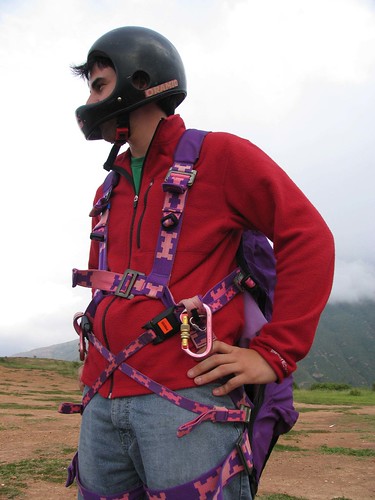Dirty dancing

Alfonso puts his left hand out and cups the air. His right hand finds its way to my left hip. "Now," he says, closing his eyes, "just feel me."
Brooke is standing five feet away in our living room. I can't see her--my eyes are closed, too--but while I stand a foot away from a grown man, one hand holding his, the other on his hip, I know she's about to keel over in a laughing fit.
The music starts. Siéntelo. I am pushed backwards, one-two, one-two, and then jerked forward. Relájate. Sideways now, right-left, right-left. No mires abajo. Forward with my left foot, back with my right foot. One-two-three, one-two-three.
I open my eyes.
"Could you feel it?" he asks, turning off the music.
"Yeah, totally," I respond. "I mean, I think so."
I wasn't certain about much last night, our first dance class with a 30-something contemporary dancer who lives here in Merida. Brooke had proposed the lessons for my birthday (whatever happened to non-participatory gifts?), and finally, two months later, here we were, just starting. I was excited, if not more than a bit nervous. I'd been well versed in the time-honored, white male bar dance--the head nod and simultaneous beer sip, likely passed down from the Vikings, or maybe the Germans--and wasn't sure if I was ready to cross over into Latino rhythms. Somehow, all those Ricky Martin and Marc Anthony jokes would come back to haunt me.
When the class started Alfonso asked us how much experience we had dancing salsa or merengue. We got the idea that he wanted him to show us what we knew, so we went with the always-safe "nada". He started us with a homily about Latino dance, about the amazing feeling of a simple rhythm in your feet--the downward, African-based beat--moving throughout your body as if impelled by the music.
We then joined hands and together kept the beat in a circle. I don-t know; after six years of playing trumpet, I don't have a problem keeping a beat. That much I've learned. I don't know if I'd go so far as to say I have rhythm, but ...
Even writing about dancing is awkward.
Anyway, the beat thing isn't my problem. I understand the one-two of my feet and the eight-beat bars. My problem is being Latino enough, loose enough, to pull off merengue or salsa.
"Don't dance like a soldier," Alfonso told me. "Let the music take you along. Let it invade you."
I knew I should have had a drink or two or six before class.
The most interesting part of the class, though, was the interaction between Brooke and me. Dancing with her has always been sort of an adventure; her idea of following is doing so until she feels the leader is incompetent, which, in my case, occurs about three seconds after starting, and then taking the reins. This woman just takes charge.
Thus, a dance class in which I am being taught to lead runs counter to our characters. Brooke can be incredibly straight-forward and single-minded when she wants something. I am more indecisive and passive. Itís not exactly Bush vs. Kerry, but you get the picture.
As you can imagine, not speaking Spanish when we first arrived here was torture for her, if only because she had to depend on me more than sheíd ever wanted.
Asking me to lead, then, and asking her to let me make decisions for the two of us, was a big step. Not surprisingly, we had to stop more than once because Brooke had started to drag me around our living room floor. There will be more classes.
The class lasted just an hour, but we were both a bit tired at the end of it. We have some music to practice before Alfonso's next visit, and we look forward to learning more. I have no delusions about my potential: I don't expect to turn heads at Hoyo del Queque, but I do hope that Brooke and I can go to a salsa place in New York and make our gringo friends think we know what we're doing.
And then there's always the intrinsic value of doing something different with your partner, of trying new things and learning new ways to communicate. After Alfonso left, Brooke and I sat, recapping the class, and she smiled.
"I'm so excited! This will tell us so much about our relationship!"
We still have so much to learn.



